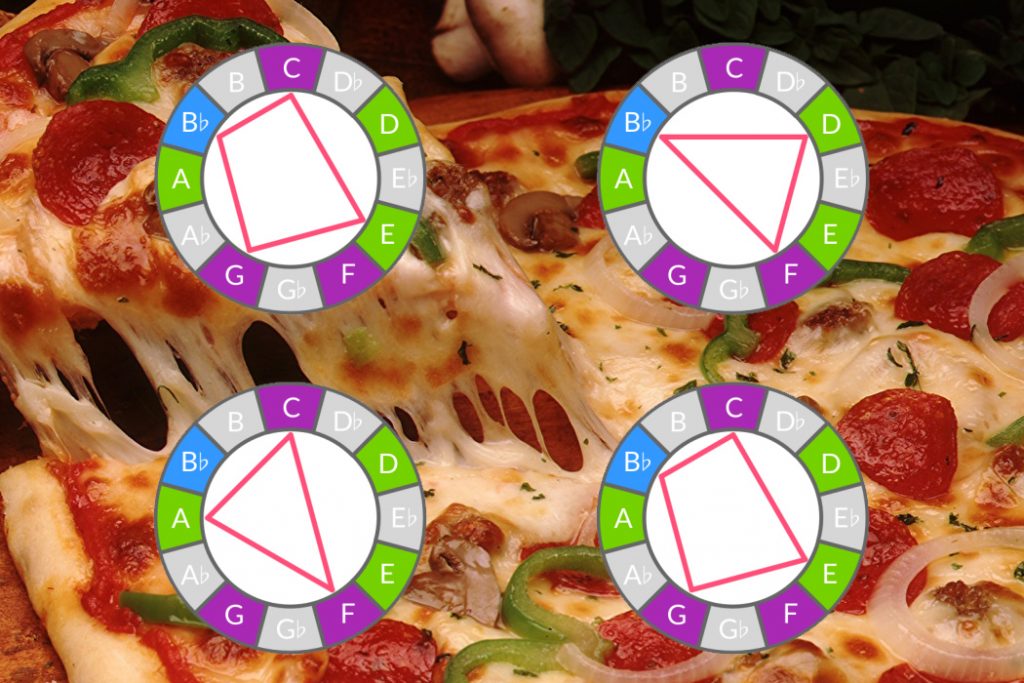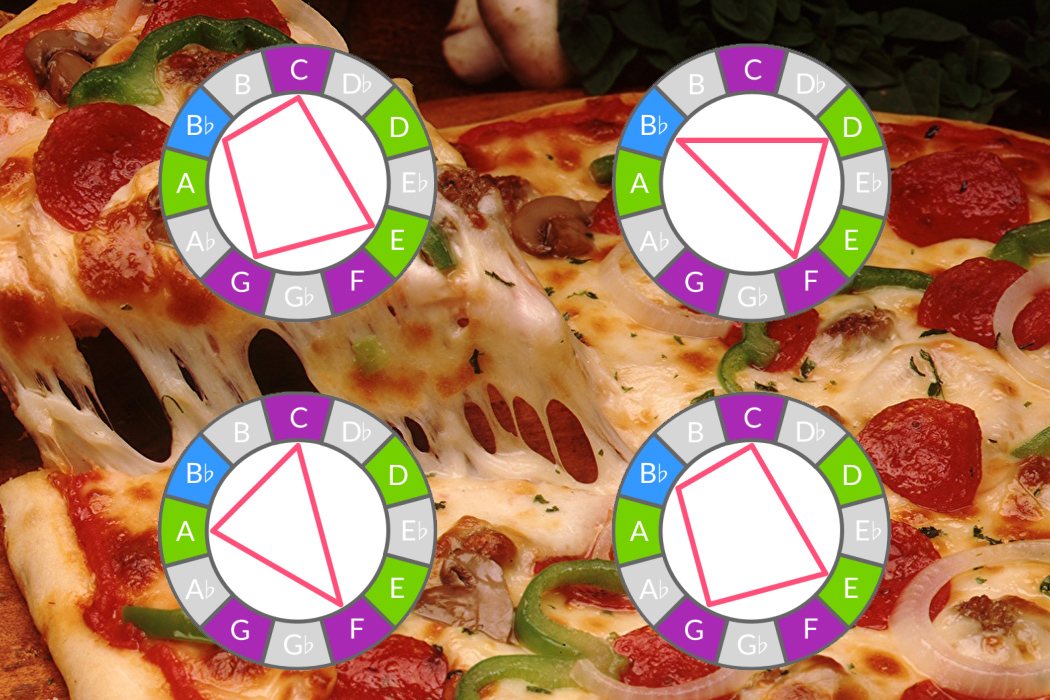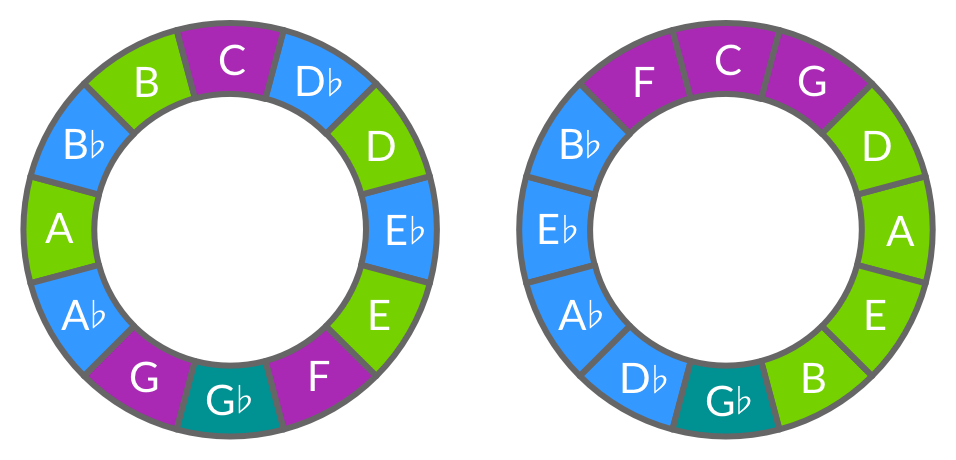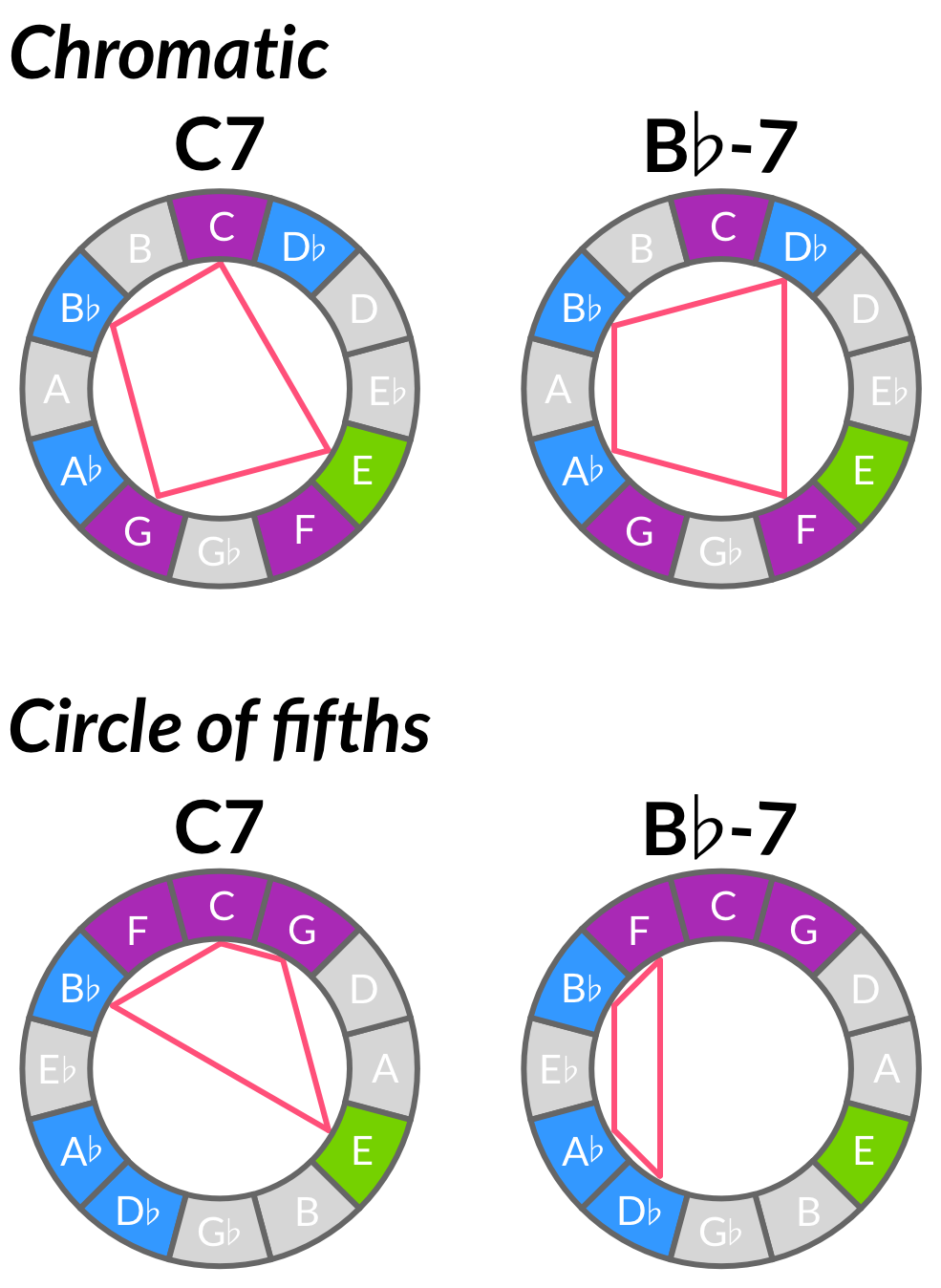+ Welcome to Soundfly! We help curious musicians meet their goals with creative online courses. Whatever you want to learn, whenever you need to learn it. Subscribe now to start learning on the ’Fly.
This article originally appeared on Ethan Hein’s blog.
The Groove Pizza uses geometry to help visualize rhythms. The NYU MusEDLab (who we partnered with to create our free Theory for Producers course series) is planning to create a similar tool for visualizing music theory by merging the aQWERTYon with the Scale Wheel.
When you put the 12 pitch classes in a circle, you can connect the dots between different notes in a chord or scale to form shapes. My hypothesis is that seeing these shapes along with hearing the notes will help people learn music theory more easily. In this post, I’ll talk through some concept images.
First, let’s look at two different ways to represent the pitch classes on a circle. On the left is the chromatic circle, showing the notes in the order of pitch height (the way they are on a piano keyboard).
On the right is the circle of fifths. These two circles have an interesting relationship: The circle of fifths is the involute of the chromatic circle. Notice that C, D, E, G♭, A♭, and B♭ are in the same places on both circles, while the other six notes trade places across the circle. Pretty cool!
The colors represent the harmonic function of each note relative to the root C. Purple notes are perfect (neither major nor minor.) Green notes are major or natural. Blue notes are minor or flatted. You could technically think of, say, B♭ as being the sharp sixth rather than the flat seventh, but that usage is rare in real life. G♭ is a special case — it’s equally likely to be the sharp fourth or flat fifth.
I represented this ambiguity by making it blue-green. (We could make it blue if we knew it was flat fifth from Locrian mode, or green if it was the sharp fourth from Lydian mode.)
Once the Scale Wheel and aQWERTYon get combined, then whenever you play more than one note at a time, they will be connected on the circle. Here are some common chord progressions, and what their shapes can tell us about how they function. First, let’s look at the I | VI– | II– | V jazz turnaround in C major.
Seeing things on the circle really helps you understand the voice leading. You can see how the notes move very little from one chord to the next. To get from CMaj7 to A–7, you just move the B to A while keeping the other three notes the same. To get from A–7 to D–7, you move the G to F and the E to D while keeping the other two notes the same. To get from D–7 to G7, you move the A to G and the C to B while keeping the other two notes the same. Finally, to get from G7 back to CMaj7, you move the D to C and the F to E while keeping the other two notes the same.
In general, any chord you can produce by moving the notes as little as possible from the current chord is likely to sound smooth and logical.
The pitch circle doesn’t represent musical “real life” perfectly — while pitch classes are circular, actual notes belong to specific octaves. That makes the voice leading harder to figure out, because you will need to introduce some jumps or additional chord voices to make it work. That said, thinking in terms of pitch class rather than pitch makes it easier to learn the concept; then you can work out the logistics of voice leading actual pitches from a place of understanding.
Next, let’s look at the Mixolydian mode — the I |♭VII | IV | I turnaround that’s ubiquitous in rock — e.g., the “na na na” section in the Beatles’ “Hey Jude.”
The circle of fifths view is more clear here. Getting from the B♭ to the F is just a matter of rotating the little triangle clockwise by one slot. If you voice the C7 chord like a jazz musician and leave out the G, then the voice leading in this progression becomes exquisitely clear and simple.
Finally, here’s a more exotic-sounding progression from Phrygian dominant, the I |♭VII– you hear in Middle Eastern and Jewish music like “Hava Nagilah.”
Seeing these chords on the circle of fifths is not very enlightening — while Western functional harmony keeps things close together on the circle of fifths, non-Western harmony jumps around a lot more. But on the chromatic circle, you can see exactly what’s happening: To get from C7 to B♭–7, B♭ stays the same, but all the other notes move one scale degree clockwise. To get from B♭–7 back to C7, B♭ stays the same while the other notes move one scale degree counterclockwise.
This is very close to the way I conceptualize this progression in my head. It’s like the notes in B♭–7 are lifting or pulling away from their homes in C7, and when you release them, they snap back into place. You could also think of this progression as being IV– to V7 in the key of F minor, in which case the B♭–7 is acting more like C7sus(♭9, ♯5). Here, the suspension metaphor makes even more sense.
Beyond the fact that it looks cool, seeing geometric representations of music gives you insight into why it works the way it does. The main insight you get from the circles is that perfect symmetry is boring. On the Groove Pizza, squares and equilateral triangles produce steady isochronous rhythms, like the four-on-the-floor kick drum pattern. These rhythms are musical, but they’re boring, because they’re perfectly predictable. The more exciting rhythms come from shapes that don’t evenly fit the metrical grid. On a 16-step grid, pentagons produce clave patterns, while hexagons make habanera and tresillo.
The same concept applies to the pitch wheel. A square on the pitch wheel is a diminished seventh chord; an equilateral triangle is an augmented triad; and a hexagon is a whole tone scale. (Interestingly, this is true both on the chromatic circle and the circle of fifths.) These sounds are fine for occasional use or special effects, but they get tedious very quickly if you repeat them too much.
By contrast, the harmonic devices we use most commonly, like major and minor triads and seventh chords, are uneven and asymmetrical. The same uneven seven-sided figure produces the major scale and its modes on the pitch wheel, and the “standard bell pattern” on the Groove Pizza. Food (ha) for thought.
Improve all aspects of your music on Soundfly.
Subscribe to get unlimited access to all of our course content, an invitation to join our members-only Slack community forum, exclusive perks from partner brands, and massive discounts on personalized mentor sessions for guided learning. Learn what you want, whenever you want, with total freedom.









